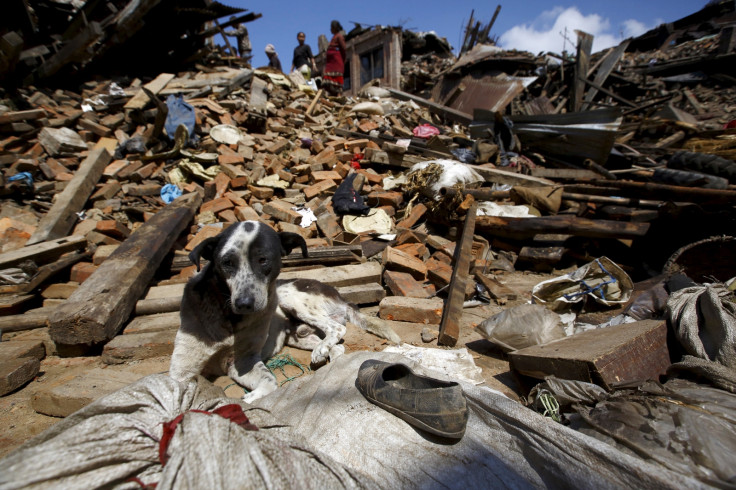Nepal earthquake: Aid struggles to reach remote Gorkha villages near quake's epicentre

Aid efforts in the Nepali mountainous areas worst struck by last Saturday's devastating earthquake are seriously hampered by bad weather, communication issues, lack of infrastructure and even congestion at Kathmandu Tribhuvan International airport, sources on the ground told IBTimes UK.
Search and rescue operations in the aftermath of the disaster, which killed more than 3,700 people and injured almost 7,000 others, are struggling to reach remote villages in the Gorkha district, where some reports say that up to 75% of houses have been destroyed by the 7.9 quake.
"The geography and terrain of Nepal and the bad state of infrastructure are hindering the aid effort," Peter Oyloe, Kathmandu-based staffer for Save the Children, an international charity that has more than 400 people in the country, told IBTimes UK.
"We have some staff based in Gorkha's remote villages but we don't have great communications with them. Not only we don't know their status but it's even difficult to get in touch with them in a short period of time to provide quick relief."
World Vision aid worker Matt Darvas was reportedly the first to get to Gorkha after last Saturday's quake. "It does not seem aid is reaching here very quickly," he told AP. "Further north from here the reports are very disturbing."
He reported that up to 75% of the buildings in Singla, a village two-days walk away, have been levelled in the disaster.
In the capital Kathmandu, doctors are moving hundreds of patients into the streets following aftershocks that rattled hospitals and buildings already damaged by Saturday's quake. Reuters reported that sick and wounded people were laying on a dusty road outside Kathmandu Medical College and doctors set up an operating theatre inside a tent.
Another Save the Children staffer in Nepal, Devendra Tak, told IBTimes UK that hospitals are overflowing with patients and that children are in desperate need for medical care and immunisation. "We are providing baby pack blankets and jumpsuits to as many as 400,000 children across the streets of Nepal," Tak said.
Pouring rain over the last two days is causing difficulties for people afraid to sleep inside for fear of aftershocks. Shortage of available food, water and electricity is putting strain on a population already severely hit by the quake.
Oyloe says that access to clean water is the most serious issue at the moment. "We've already distributed bottles of water to the population in the most heavily affected areas in Gorkha," he said. "There's a tremendous number of buildings destroyed there."
The bad weather is hindering access to villages in the Gorkha district closer to the quake's epicentre, some of which are reachable only on foot. Nepal has a poorly maintained road network and a limited number of helicopters which could be instrumental to get to the most remote areas hit by the earthquake.
World Vision said that some areas can be three days walk from Gorkha's main disaster centre.
"In those villages that have been reached, the immediate needs are great including the need for search and rescue, food items, blankets and tarps, and medical treatment," the group told AP.
Maurizio Busatti, Nepal chief of mission for the International Organization for Migration (IOM), said in a statement that according to aerial and satellite images "whole towns have been flattened" in the area.
"We still don't know the full extent of the damage, nor the number of lives lost, but it is inevitable that it will be much higher as we reach towns and villages which are currently inaccessible," he said.
ITV reported that roads surrounding Kathmandu are heavily blocked due to landslides, further hampering the aid efforts.
Congestion at the Tribhuvan International Airport in the capital added to the slow progress of relief, as well as a patchy mobile phone and internet coverage.
Three of Singapore Air Force's C-130 aircraft, laden with relief aid and rescue teams were forced to divert to other airports.
"Ground commanders tell me that conditions at Kathmandu can be challenging. The airport is about 1,300m above sea level and weather conditions can change rapidly. Frustrating to all concerned, when so much help is needed," Ng Eng Hen, Singapore defence minister, wrote on Facebook.
India's defence ministry also tweeted that four Indian air force aircraft carrying aid had to return to New Delhi because of chaos at Kathmandu's small airport.
British aid planes were also forced to land in India after a botched attempt to reach the Nepal's capital.
Down there is Kathmandu but we can't land as airport too congested. Landed in Lucknow, India as no fuel! @GMB pic.twitter.com/WzSerBbioa
— Jonathan Swain (@SwainITV) April 27, 2015© Copyright IBTimes 2025. All rights reserved.




















